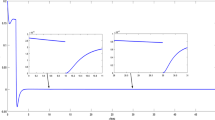Abstract
In this paper, a chemostat model with periodically pulsed input and time delay is considered. We show that there exists a microorganism-free periodic solution, which is globally attractive when the period of impulsive effect is less than some critical value. Further, we give the sufficient conditions for the permanence of the model with time delay and pulsed input. We show that time delay, impulsive input can bring different effects on the dynamic behavior of the model by numerical analysis. We show that impulsive effect destroys the equilibria of the unforced continuous system and initiates periodic solution. Our results can be applied to culture the microorganism.
Similar content being viewed by others
References
Wanng, L., Wolkowicz, G.S.K.: A delayed chemostat with general nonmonotone response functions and differential removal rates. J. Math. Anal. Appl. 321, 452–468 (2006)
Rehim, H., Teng, Z.: Permanence average persistence and extinction in non-autonomous single-species growth chemostat models. Adv. Complex Syst. 9(1–2), 41–58 (2006)
Lakmeche, A., Arino, O.: Bifurcation of non trivial periodic solutions of impulsive differential equations arising chemotherapeutic treatment. Dyn. Contin. Discrete Impuls. Syst. 7, 165–87 (2000)
Smith, H.L.: Competitive coexistence in an oscillating chemostat. SIAM J. Appl. Math. 18, 498–522 (1981)
Lenas, P., Pavlous, S.: Coexistence of three competing microbial populations in a chemostat with periodically varying dilution rate. Math. Biosci. 129, 111–142 (1995)
Pilyugin, S.S., Waltman, P.: Competition in the unstirred chemostat with periodic input and washout. SIAM J. Appl. Math. 59, 1157–77 (1999)
Cunningham, A., Nisbet, R.M.: Transients oscillations in continuous culture. In: Mathematics in Microbiology. CRC Press, Boca Raton (1983)
Cushing, J.M.: Integra-Differential Equations and Delay Models in Population Dynamics. Springer, Heidelberg (1977)
Freedman, H.I., Sree Hari Rao, V.: The trade-off between mutual interference and time lags in predator-prey systems. Bull. Math. Biol. 45, 991–1004 (1983)
Freedman, H.I., Sree Hari Rao, V., Jayalakshmi, K.: Stability, persistence and extinction in a predator-prey system with discrete and continuous time delays. In: WSSIAA, vol. 1, 221–238. World Scientific, Singapore (1993)
Gopalamy, K.: Stability and Oscillations in Delay Differential Equations of Population Dynamics. Kluwer Academic, Dordrecht (1992)
Kuang, Y.: Delay differential equations with applications in population dynamics. Academic Press, New York (1993)
Macdonald, N.: Time Lags in Biological Models. Springer, Heidelberg (1978)
Nisbet, R.M., Gurney, W.S.C.: Modelling Fluctuating Populations. Wiley, New York (1982)
Butler, G.J., Hsu, S.B., Waltman, P.: A mathematical models of the chemostat with periodic washout rate. SIAM J. Appl. Math. 45, 435–439 (1985)
Hale, J., Somolinos, A.S.: Competition for fluctuating nutrient. J. Math. Biol. 9, 255–280 (1980)
Hsu, S.B.: A competition model for a seasonally fluctuating nutrient. J. Math. Biol. 9, 115–132 (1980)
Smith, H.L.: Competitive coexistence in an oscillating chemostat. SIAM J. Appl. Math. 40, 498–521 (1981)
Wolkowicz, G.S.K., Xia, H., Ruan, S.: Competition in the chemostat: A distributed delay model and its asymptotic behavior. SIAM J. Appl. Math. 57, 1281–310 (1997)
Caperon, J.: Time lag in population growth response of Isochrysis galbana to a variable nitrate environment. Ecology 50, 188–192 (1969)
Waltman, P.: Co-existence in chemostat-like models. Rocky Mt. J. Math. 20, 777–807 (1990)
Bush, A.W., Cook, A.E.: The effect of time delay and growth rate inhibition in the bacterial decomposition of waste water. J. Theor. Biol. 63, 385–395 (1975)
Pang, G.P., Chen, L.S.: A delayed SIRS epidemic model with pulse vaccination. Chaos Solitons Fractals 34(5), 1629–1635 (2007)
Z Meng, X., Jiao, J.J., Chen, L.S.: Two profitless delays for an SEIRS epidemic disease model with vertical transmission and pulse vaccination. Chaos Solitons Fractals 40(5), 2114–2125 (2009)
Pang, G.P., Wang, F.Y., Chen, L.S.: Analysis of a Monod-Haldene type food chain chemostat with periodically varying substrate. Chaos Solitons Fractals 38(3), 731–742 (2008)
Hui, J., Chen, L.S.: Dynamic complexities in a periodically pulsed ratio-dependent predator-prey ecosystem modeled on a chemostat. Chaos Solitons Fractals 29(2), 407–416 (2006)
Zhao, Z., Song, X.Y.: On the study of chemostat model with pulsed in a polluted environment. Discrete Dyn. Nature Soc. 2007, 90158 (2007), 12 pages
Berezansky, L., Braveman, E.: Linearized oscillation theory for a nonlinear delay impulsive equation. J. Comput. Appl. Math. 161, 477–495 (2003)
Liu, X., Ballinger, G.: Boundedness for impulsive delay differential equations and applications to population growth models. Nonlinear Anal. 53, 1041–1062 (2003)
Yan, J.: Stability for impulsive delay differential equations. Nonlinear Anal. 63, 66–80 (2005)
Lakshmikanthan, V., Bainov, D.D., Simeonov, P.: Theory of Impulsive Differential Equations. World Scientific, Singapore (1989)
Kuang, Y.: Delay Differential Equations with Application in Population Dynamics. Academic Press, San Diego (1993)
Author information
Authors and Affiliations
Corresponding author
Additional information
This work is supported by the National Natural Science Foundation of China (No. 10971001) and Henan Science and Technology Department (No. 082102140025 and 092300410228).
Rights and permissions
About this article
Cite this article
Zhao, Z., Zhang, X. & Chen, L. Nonlinear modelling of chemostat model with time delay and impulsive effect. Nonlinear Dyn 63, 95–104 (2011). https://doi.org/10.1007/s11071-010-9788-1
Received:
Accepted:
Published:
Issue Date:
DOI: https://doi.org/10.1007/s11071-010-9788-1




